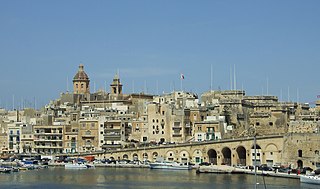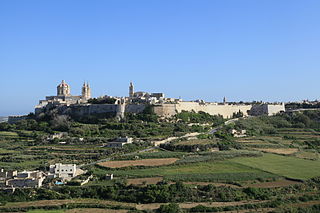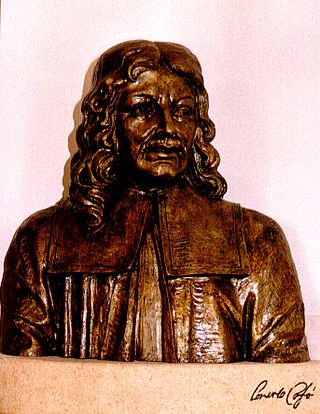
Birgu, also known by its title Città Vittoriosa, is an old fortified city on the south side of the Grand Harbour in the South Eastern Region of Malta. The city occupies a promontory of land with Fort Saint Angelo at its head and the city of Cospicua at its base. Birgu is ideally situated for safe anchorage, and over time it has developed a very long history with maritime, mercantile and military activities.

Rabat is a town in the Northern Region of Malta, with a population of 11,497 as of March 2014. It adjoins the ancient capital city of Mdina, and a north-western area formed part of the Roman city of Melite until its medieval retrenchment.

Żurrieq is a town in the Southern Region of Malta. It is one of the oldest towns in the country, and has a population of 11,823 inhabitants as of March 2014. Żurrieq is one of the 10 parishes to be documented in 1436 and is dedicated to Saint Catherine. The island of Filfla is administratively a part of the town. The town stretches from Nigret to Ħal Far. In old times the town had a border with Żejtun. The village of Qrendi used to be part of the parish of Żurrieq until 1618 when it was made into its own parish.

Żejtun is a town in the South Eastern Region of Malta, with a population of 11,218 at the end of 2016. Żejtun is traditionally known as Città Beland, a title conferred by the grandmaster of the Order of the Knights of Malta, Ferdinand von Hompesch zu Bolheim in 1797. Before that, the village was known as Casale Santa Caterina, named after its patron saint and parish titular.

António Manoel de Vilhena was a Portuguese nobleman who was the 66th Prince and Grand Master of the Order of St. John of Jerusalem from 19 June 1722 to his death in 1736. Unlike a number of the other Grand Masters, he was benevolent and popular with the Maltese people. Vilhena is mostly remembered for the founding of Floriana, the construction of Fort Manoel and the Manoel Theatre, and the renovation of the city of Mdina.

St John's Co-Cathedral is a Catholic co-cathedral in Valletta, Malta, dedicated to Saint John the Baptist. It was built by the Order of St. John between 1573 and 1578, having been commissioned by Grand Master Jean de la Cassière as the Conventual Church of Saint John.

Mdina, also known by its Italian epithets Città Vecchia and Città Notabile, is a fortified city in the Northern Region of Malta which served as the island's former capital, from antiquity to the medieval period. The city is still confined within its walls, and has a population of 250, but it is contiguous with the town of Rabat, which takes its name from the Arabic word for suburb, and has a population of over 11,000.

Maltese architecture has its origins in prehistory, and some of the oldest free-standing structures on Earth – a series of megalithic temples – can be found on Malta. The islands were colonized by the Phoenicians and later the Romans, who established the cities of Melite and Gaulos. Although these were substantial settlements and are known to have had numerous temples, churches and palaces, few remains have survived apart from some architectural fragments.
The Lascaris Towers are a series of mostly small coastal watchtowers built in Malta by the Order of Saint John between 1637 and 1652. The first seven towers were built around the coast of mainland Malta in 1637 and 1638. Between 1647 and 1652, a large tower was also built on mainland Malta, and two smaller ones were built on Gozo.

The Metropolitan Cathedral of Saint Paul, commonly known as St Paul's Cathedral or the Mdina Cathedral, is a Catholic cathedral in Mdina, Malta, dedicated to St. Paul the Apostle. The cathedral was founded in the 12th century, and according to tradition it stands on the site where Roman governor Publius met St. Paul following his shipwreck on Malta. The original cathedral was severely damaged in the 1693 Sicily earthquake, so it was dismantled and rebuilt in the Baroque style to a design of the Maltese architect Lorenzo Gafà between 1696 and 1705. The cathedral is regarded as Gafà's masterpiece.

Lorenzo Gafà (1639–1703) was a Maltese Baroque architect and sculptor. He designed many churches in the Maltese Islands, including St. Paul's Cathedral in Mdina and the Cathedral of the Assumption in Victoria, Gozo. He was the younger brother of the sculptor Melchiorre Cafà.

The fortifications of Malta consist of a number of walled cities, citadels, forts, towers, batteries, redoubts, entrenchments and pillboxes. The fortifications were built over hundreds of years, from around 1450 BC to the mid-20th century, and they are a result of the Maltese islands' strategic position and natural harbours, which have made them very desirable for various powers.

The Chapel of the Annunciation is a Medieval Roman Catholic church located in Ħal-Millieri, limits of Żurrieq, Malta.

The fortifications of Mdina are a series of defensive walls which surround Mdina, the former capital city of Malta from antiquity to the medieval period. The city was founded as Maleth by the Phoenicians in around the 8th century BC, and it later became part of the Roman Empire under the name Melite. The ancient city was surrounded by walls, but very few remains of these have survived.

Mdina Gate, also known as the Main Gate or the Vilhena Gate, is the main gate into the fortified city of Mdina, Malta. It was built in the Baroque style in 1724 to designs of Charles François de Mondion, during the magistracy of Grand Master António Manoel de Vilhena.

Melite or Melita (Latin) was an ancient city located on the site of present-day Mdina and Rabat, Malta. It started out as a Bronze Age settlement, which developed into a city called Ann under the Phoenicians and became the administrative centre of the island. The city fell to the Roman Republic in 218 BC, and it remained part of the Roman and later the Byzantine Empire until 870 AD, when it was captured and destroyed by the Aghlabids. The city was then rebuilt and renamed Medina, giving rise to the present name Mdina. It remained Malta's capital city until 1530.

The Church of the Annunciation also known as The Carmelite Church is a rich Baroque priory church of the Priory of Our Lady of Mount Carmel located in Mdina, Malta.

The Church and Monastery of St Peter is a Catholic Benedictine monastery for Cloistered nuns located in the medieval city of Mdina, Malta. The adjacent church is dedicated to St Peter and St Benedict.

St. Catherine's Old Church, also known as St. Gregory's Church, is a Roman Catholic church in Żejtun. The church and its complex sit towards the outskirts of the town, commanding views over Marsascala Bay, St. Thomas' Bay and Marsaxlokk harbour. The church is colloquially known as Saint Gregory's due to a traditional procession held on the first Wednesday following Easter Sunday. Its dedication to Catherine of Alexandria dates back to an original chapel on this site, which was one of the eight mother churches on Malta. The church stands next to the three cemeteries of Żejtun, dedicated to St. Rocco, St. Gregory and St. Catherine. The church's functions as the parish church of Żejtun were taken over by a new parish church, also dedicated to St. Catherine, and designed by Lorenzo Gafà.

The Chapel of St Nicholas is a small, disused Roman Catholic church located in the historic and medieval town of Mdina, Malta.






















